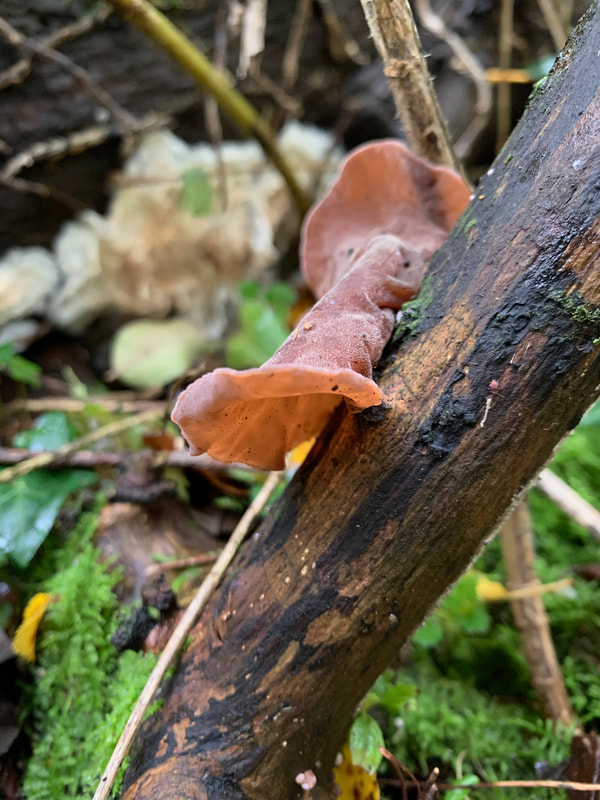Wildlife to watch in November
|
Jelly Ear Fungus
This rubbery little fungus is Jelly Ear and is easy to spot this time of year growing on old Elder. Alternative names include Wood Ear and Judas’s Ear. The latter name alludes to the fact that Judas hanged himself on an Elder tree after betraying Jesus Christ to his executioners and the ‘ears’ represent his tormented soul. Jelly Ear is a great survivor. It naturally de- and re-hydrates in the wild, often looking like shrivelled, hard dark knobs in warm dry weather. It can also still grow after freezing and thawing. Jelly Ear fungi have been a staple in Traditional Chinese Medicine for thousands of years, where they were used to help improve breathing, sore throats, reduce colds and fevers, enhance well-being and to boost circulation. |
|
Wrinkled Peach fungus
The beautifully coloured Wrinkled Peach fungus (Rhodotus palmatus) likes to grow on dead and rotting elm. After the Dutch elm disease outbreak they became quite common, now it is fairly rare although it will grow on other hardwoods. Other common names include Rosy Veincap, Apricot fungus and Netted Rhodotus. It is considered inedible. The species is now on the Global Fungi Red List and considered an endangered species across much of Europe. |
Common Buzzard
The Common Buzzard was once a rare site in Essex due in part to the spread of the myxomatosis virus to the UK in the 1950s, estimated to have killed more than 99% of the country's rabbits, removing much of the buzzard's food supply. The use of organochlorine pesticides in the 1950s and 1960s affected its reproductive capacity. The UK population is thought to have been about 10,000 breeding pairs by the mid-1960s. Today they are making a comeback and you can often hear the distinctive mewing call before spotting them high in the sky. They like to rest on fence posts and tree branches and can often be heard and seen along the Flitch Way.
The typical life span is 12 years and once they find a mate, they stay together for life. Their main prey is small mammals, including voles, mice, rats, moles, rabbits and hares, but if they are scarce, they can live on worms and insects.
The typical life span is 12 years and once they find a mate, they stay together for life. Their main prey is small mammals, including voles, mice, rats, moles, rabbits and hares, but if they are scarce, they can live on worms and insects.
Holly
|
Holly provides dense cover and good nesting opportunities for birds, while its deep, dry leaf litter may be used by hedgehogs and small mammals for hibernation. The smooth leaves found at the tops of holly trees are a winter source of food for deer. The berries are a vital source of food for birds in winter, and are also eaten by small mammals such as wood mice and dormice. Holly branches have long been used to decorate homes in winter. The tree was seen as a fertility symbol and a charm against witches, goblins and the devil. It was thought to be unlucky to cut down a holly tree. |
Also look out for
Rosehips
|
Rosehips are the seed pods of roses. If you leave the spent flowers on the rose bush at the end of the season, you should see these small, berry sized, reddish seed balls left on the tips of the stems. They are also edible and birds enjoy them too. This fruit, derived from the rose plant, is not only an excellent source of vitamin C, but studies show that it may reduce the symptoms of osteoarthritis and help sore, achy joints function better. However, it is best to leave the hips for fruit eating birds such as Thrushes, Blackbirds, Fieldfares and Waxwings, which then disperse the seeds in their droppings. Some birds, particularly finches, also eat the seeds. |
Old Man's Beard
|
Like other members of the Clematis genus, old man’s beard or traveller’s joy climbs or scrambles over other plants using its leaf stalks and flower stalks. The leaves are not unlike the familiar garden forms of Clematis. The leaf stalks entwine around any convenient support / structure in their vicinity and then lignify (become woody).
As the plant grows and matures, it forms woody stems which can be as thick as a wrist; the plant can grow to a height of 12 metres or more. |
Go to next month's wildlife





